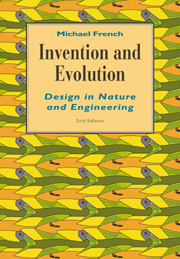Book contents
- Frontmatter
- Contents
- Preface to the second edition
- Preface to the first edition
- Acknowledgements
- 1 The designed world
- 2 Energy
- 3 Materials
- 4 Mechanism
- 5 Structures
- 6 Systems
- 7 The practice, principles and philosophy of design
- 8 Economy, form and beauty
- 9 Production, reproduction, evolution and design
- 10 Designing and inventing
- 11 Some case studies
- Questions
- Answers
- Suggestions for further reading
- Index
7 - The practice, principles and philosophy of design
Published online by Cambridge University Press: 06 January 2010
- Frontmatter
- Contents
- Preface to the second edition
- Preface to the first edition
- Acknowledgements
- 1 The designed world
- 2 Energy
- 3 Materials
- 4 Mechanism
- 5 Structures
- 6 Systems
- 7 The practice, principles and philosophy of design
- 8 Economy, form and beauty
- 9 Production, reproduction, evolution and design
- 10 Designing and inventing
- 11 Some case studies
- Questions
- Answers
- Suggestions for further reading
- Index
Summary
Introduction
Earlier chapters have shown some of the problems facing the functional designer and some of the solutions that have been found or copied from nature. Some areas of knowledge important in design have been touched upon – mechanics, materials, kinematics, structures – but nothing has emerged in the way of a systematic method of design. Indeed, a truly systematic approach is as unthinkable in such a field as it would be, say, in play writing. All there can be is guidance, generalisations and principles as broad as the unities of time, place and action in drama. However, there are three great sources of help to the designer, which will be studied in this chapter.
The first is practice, what has been done already, in living organisms, or, most often, by other designers. The second is principles of design, derived by reflection, or by abstraction from a wide knowledge of practice, or both. The last is the philosophy of design, which manifests itself as a single strong thread of sometimes rather abstract reasoning running through certain designs, usually having an apparent inevitability. It is rare, but perhaps should be more common; certainly, it is difficult to explain, even with examples, but it can be recognised.
Practice
The human designer in his work is able to draw upon a vast number of examples, mostly from the works of men but occasionally from the living world.
- Type
- Chapter
- Information
- Invention and EvolutionDesign in Nature and Engineering, pp. 180 - 221Publisher: Cambridge University PressPrint publication year: 1994

